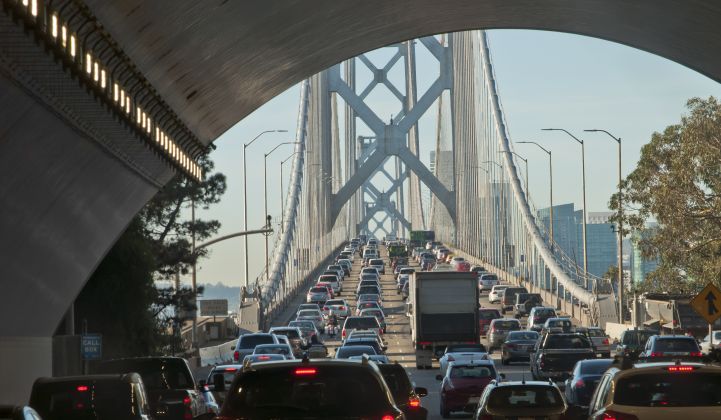Self-driving cars have the potential to revolutionze the flow of people and goods. Car crashes could become much rarer and trips much more efficient. For those who drive to work, daily commutes could become more productive and fun.
But for society, autonomous vehicles may come with significant downsides. As automotive players ranging from BMW to Uber look to develop self-driving cars and services, some studies have shown that the vehicles could make traffic jams worse.
In one example, researchers in 2018 tried to mimic the way car owners would use self-driving cars by giving subjects in the San Francisco Bay area a free chauffeur-driven vehicle for a week. The results were hardly encouraging: The arrangement resulted in increases in vehicle-miles traveled and the number of trips, particularly in the evening hours. And a substantial portion of the trips were made on a "zero-occupancy" basis, with no rider in the car.
Lead author Mustapha Harb, of the University of California at Berkeley, told GTM that having a privately owned autonomous vehicle might not only encourage people to take the car for trips they would not have bothered with before but could also lead to the rise of what are termed "ghost trips."
“A bike or walking trip to the store to pick up a chocolate bar will not be as attractive as the convenient option of sending an empty car to do the pickup,” Harb theorized.
“We have been working hard on increasing the number of people in cars and encouraging pooling,” he said. “With autonomous vehicles, we will actually have cars with zero people on the roads. The problem is [that] zero-occupancy vehicle trips are very convenient.”
A new way to avoid paying for parking
Ghost trips would be bad enough if self-driving cars were just heading to and from a pickup point. But more recent research by Adam Millard-Ball, an associate professor of environmental studies at the University of California, Santa Cruz, suggests vehicles may decide to stay on the road for long periods of time simply to avoid paying for parking.
Using data from San Francisco, Millard-Ball calculated that autonomous vehicles could lead to a doubling in vehicle travel to, from and within dense urban cores.
“Planners and EV designers seem to have some expectations that the cars would do what was socially optimal, that they’ll behave with the interests of the city in mind,” Millard-Ball said. “But we know that’s not how individuals and firms behave. They do what is best for them.”
Most car trips in the San Francisco area involve relatively long distances but fairly short stops at the point of destination, Millard-Ball found. Under such circumstances, it makes little sense for a vehicle to travel back to its base while waiting for its owner; instead, in the absence of free parking, cars may simply drive around while waiting for their owners to return.
In less-dense environments, where parking is more abundant, autonomous vehicles may bring new efficiencies — for example, by letting cars park more closely together, without a need to leave room for passengers to get out.
Possible solutions to problems with autonomous vehicles
To overcome the parking problem in urban areas, Millard-Ball suggests implementing time-and-distance pricing on self-driving cars within city centers, similar to the congestion charges that are already being imposed on drivers in some metropolitan areas. “If we don’t do anything to rethink how we allocate city street space, then we’re likely to have gridlock,” he said.
Harb said pricing would be key to making carpooling more attractive; ridesharing services and transit agencies could partner to combine both modes of transport efficiently. And there should be a tax on cars undertaking ghost trips, he added.
How autonomous vehicles are put to use will depend on who owns them. Level 4 autonomous vehicles will be much costlier to build than Level 3 models, said Nick Albanese, head of new mobility research at Bloomberg NEF.
"Our current take is that fully autonomous vehicles will only be deployed in shared fleets, in which they will have higher utilization than privately owned vehicles,” Albanese said in an email.
Bloomberg NEF estimates the global fleet of shared fully autonomous vehicles could exceed 20 million by 2040, but that will only be equal to roughly 1 percent of passenger vehicles worldwide. “These robo-taxis will increase demand for travel, but also decrease demand for private-car ownership," Albanese said.
Policymakers may feel they have plenty of time to wrestle with questions about autonomous vehicles. But the coronavirus outbreak has put a black cloud over mass transit and shared ridership models in urban areas, Harb noted.
“We need to figure out how to reverse the trend of unimodality and car dependency," he said. "If an autonomous-vehicle future means everyone uses their own personal autonomous vehicle, then the technology will bring more harm than benefit.”




